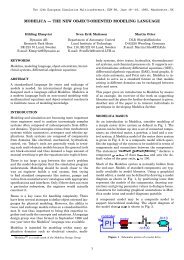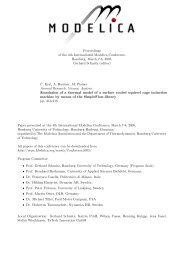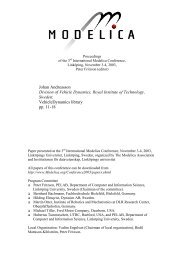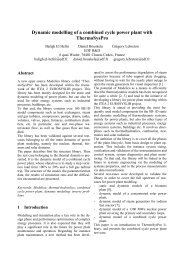Hilding Elmqvist, Hubertus Tummescheit and Martin Otter ... - Modelica
Hilding Elmqvist, Hubertus Tummescheit and Martin Otter ... - Modelica
Hilding Elmqvist, Hubertus Tummescheit and Martin Otter ... - Modelica
Create successful ePaper yourself
Turn your PDF publications into a flip-book with our unique Google optimized e-Paper software.
H. <strong>Elmqvist</strong>, H. <strong>Tummescheit</strong>, M. <strong>Otter</strong> Object-Oriented Modeling of Thermo-Fluid Systems<br />
medium is defined by <strong>Modelica</strong>_Media.<br />
Interfaces.PartialMedium that has the following<br />
structure:<br />
partial package PartialMedium<br />
import SI = <strong>Modelica</strong>.SIunits;<br />
constant String mediumName;<br />
constant String substanceNames;<br />
constant Boolean incompressible;<br />
constant Boolean reducedX;<br />
constant Integer nX = size(<br />
substanceNames,1);<br />
record BasePropertiesRecord<br />
AbsolutePressure p;<br />
Temperature T;<br />
Density d;<br />
SpecificInternalEnergy u;<br />
SpecificEnthalpy h;<br />
MassFraction X[nX];<br />
end BasePropertiesRecord;<br />
replaceable model BaseProperties<br />
extends BasePropertiesRecord;<br />
// parameter declarations<br />
end BaseProperties;<br />
// optional medium properties<br />
replaceable partial function<br />
dynamicViscosity<br />
input BasePropertiesRecord<br />
medium;<br />
output DynamicViscosity eta;<br />
end dynamicViscosity;<br />
// other optional functions<br />
// medium specific types<br />
type AbsolutePressure =<br />
SI.AbsolutePressure (<br />
min = 0,<br />
max = 1.e8,<br />
nominal = 1.e5,<br />
start = 1.e5);<br />
type DynamicViscosity = ...;<br />
// other type definitions<br />
end PartialMedium;<br />
We will discuss all parts of this package in the<br />
following paragraphs. An actual medium model<br />
should extend from PartialMedium <strong>and</strong> has to<br />
provide implementations of the various parts.<br />
The constants at the beginning of the package<br />
(with exception of nX) do not have a value yet (this<br />
is valid in <strong>Modelica</strong>), but a value has to be provided<br />
when extending from package PartialMedium. Once<br />
a value is given, it cannot be changed any more. The<br />
reason to use constants instead of parameters in the<br />
model BaseProperties is that some of these<br />
constants have to be used in connector definitions<br />
(such as the number of mass fractions nX). When<br />
defining the connector, only constants in packages<br />
can be accessed, but not parameters in a model,<br />
because a connector cannot contain an instance of<br />
BaseProperties.<br />
The record BasePropertiesRecord contains the<br />
variables primarily used in balance equations. Three<br />
equations for these variables have to be provided by<br />
every medium in model BaseProperties. Optional<br />
medium properties are defined by functions, such as<br />
the function “dynamicViscosity” (see code Section<br />
above) to compute the dynamic viscosity. Model<br />
BaseProperties extends from the record <strong>and</strong> the<br />
optional functions have an instance of this record as<br />
an input argument. This construction simplifies the<br />
usage considerably as demonstrated in the following<br />
code fragment:<br />
replaceable package<br />
Medium = PartialMedium;<br />
Medium.BaseProperties medium;<br />
Medium.DynamicViscosity eta;<br />
...<br />
U =m*medium.u; //Internal energy<br />
eta=Medium.dynamicViscosity(medium);<br />
“Medium” is the medium package that satisfies the<br />
requirements of a “PartialMedium” (when using the<br />
model above, a value for Medium has to be<br />
provided by a redeclaration). The “medium”<br />
component is an instance of the model<br />
“Medium.BaseProperties” <strong>and</strong> contains the core<br />
medium equations. Variables in this model can be<br />
accessed just by dot-notation, such as medium.u or<br />
medium.T. If an optional medium variable has to be<br />
computed, the corresponding function from the<br />
actual Medium package is called, such as<br />
“Medium.dynamicViscosity”. The medium instance<br />
can be given as input argument to this function,<br />
because model Medium.BaseProperties is a subclass<br />
of BasePropertiesRecord – the argument required<br />
from the function.<br />
If a medium model does not provide<br />
implementations of all optional functions <strong>and</strong> one of<br />
these functions is called in a model, an error occurs<br />
during translation since the not redeclared optional<br />
functions have the “partial” attribute. For example,<br />
if function dynamicViscosity is not provided in the<br />
medium model when it is used, only simple pressure<br />
drop loss models without a reference to the viscosity<br />
can be used <strong>and</strong> not the sophisticated ones.<br />
At the bottom of the PartialMedium package<br />
type declarations are present that are used in all<br />
other parts of the PartialMedium package <strong>and</strong> that<br />
should be used in all models <strong>and</strong> connectors where a<br />
medium model is accessed. The reason is that<br />
minimum, maximum, nominal <strong>and</strong> sometimes also<br />
The <strong>Modelica</strong> Association <strong>Modelica</strong> 2003, November 3-4, 2003

















